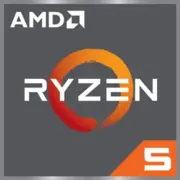AMD Ryzen 5 5605G

AMD Ryzen 5 5605G: A Comprehensive Review of the Processor for Budget Builds and Beyond
Key Specifications: Architecture, Manufacturing Process, and Key Features
The AMD Ryzen 5 5605G processor, released in 2022, belongs to the APU (Accelerated Processing Unit) lineup — hybrid solutions that combine CPU and integrated graphics. It is based on the Zen 3 architecture (codename Cezanne) and is manufactured using a 7nm process, ensuring high energy efficiency. Key parameters include:
- 6 cores / 12 threads;
- Base clock: 3.9 GHz, maximum in turbo mode — 4.4 GHz;
- 16 MB L3 cache;
- TDP: 65 W;
- Integrated graphics Radeon Vega 7 (448 stream processors, clock rate up to 1900 MHz).
Key Features:
- Integrated Vega 7 graphics — allows for light gaming without a discrete graphics card;
- Supports PCIe 3.0 (unlike Ryzen 5000 without graphics, which offers PCIe 4.0);
- Technologies Precision Boost 2 and Smart Access Memory (when used with AMD GPUs).
Practical example: In tests, Vega 7 handles CS:GO on medium settings (1080p, 60+ FPS) and rendering in Blender, making the APU versatile for non-demanding tasks.
Compatible Motherboards: Sockets and Chipsets
The Ryzen 5 5605G uses the AM4 socket, providing access to a vast selection of motherboards. However, it is essential to consider:
- Supported chipsets: A520, B550, X570 (BIOS update required for some motherboards), as well as older B450/X470 (after flashing).
- Recommendations:
- B550 motherboards — optimal due to the balance of price and functionality (for example, ASUS TUF B550-Plus);
- For budget builds, A520 (Gigabyte A520M S2H) is suitable;
- X570 chipsets are excessive unless PCIe 4.0 for storage is needed.
Important! Some motherboards require a BIOS update to work with Cezanne. Check for support on the manufacturer's website or look for models marked "Ryzen 5000 Ready."
Supported Memory: DDR4 and Configuration Nuances
The processor only works with DDR4 (DDR5 is not supported). Recommendations:
- Optimal frequency: 3200–3600 MHz (reduces latency and improves Vega 7 performance);
- Capacity: 16 GB (2x8 GB) in dual-channel mode — critical for integrated graphics, as it uses system RAM as video memory.
Example: In games, the difference between single-channel and dual-channel memory can reach 20–30% FPS. For video editing, 32 GB DDR4-3200 will accelerate rendering.
Power Supply: How to Choose Correctly
With a TDP of 65 W and no discrete graphics card, a 450–500 W PSU will suffice (for example, be quiet! System Power 9 500W). However:
- If you plan to add a graphics card (for example, RTX 3060), go for 650 W;
- Consider efficiency: 80+ Bronze certification is the minimum for stable operation.
Advice: Even for an APU, do not skimp on the PSU. Cheap models can "drop" voltage, affecting system stability.
Pros and Cons of Ryzen 5 5605G
Advantages:
- Powerful integrated graphics for an APU;
- Low power consumption and heat generation;
- 6 cores for multitasking (streaming, working with office applications);
- Support for modern interfaces (USB 3.2, NVMe).
Disadvantages:
- No PCIe 4.0 — storage speeds are limited;
- Weak overclocking potential (most models have a locked multiplier);
- Vega 7 lags behind entry-level discrete GPUs (GTX 1650).
Usage Scenarios: Where Its Potential Shines
1. Office Tasks and Multimedia: Streaming video (4K), working with a browser (20+ tabs), office applications.
2. Light Gaming: Dota 2, GTA V, Fortnite on low-medium settings (1080p, 30–60 FPS).
3. Work Tasks: Rendering in Blender, editing in DaVinci Resolve (with 32 GB of RAM), code compilation.
Example: Users note that the APU handles game streaming through OBS (provided hardware encoding is used).
Comparison with Competitors: Intel vs AMD
Main competitors:
- Intel Core i5-12400 (UHD 730): Better in single-threaded tasks, but weaker integrated graphics. Suitable if PCIe 5.0 and DDR5 are needed, but at a higher cost.
- Ryzen 5 5600G: A twin to the 5605G with slightly higher GPU clock (1900 vs 1800 MHz). In games, the difference is about 5–7% FPS.
- Intel Core i3-12100: Cheaper, but has only 4 cores. A choice if the budget is tight and graphics are not critical.
Conclusion: The 5605G outperforms Intel in scenarios where integrated graphics and multi-threading are essential.
Practical Assembly Tips
1. Motherboard: Choose B550 for PCIe 4.0 (if fast NVMe is needed) or A520 for savings.
2. Cooling: The stock cooler is sufficient, but for quieter operation, consider the DeepCool GAMMAXX 400.
3. Memory: Dual-channel DDR4-3200 is a must. Example: Kingston Fury Beast.
4. Storage: An NVMe SSD (for example, Samsung 970 Evo Plus) will speed up system boot and file handling.
5. Case: Ensure good ventilation. A budget option is the Zalman S2.
Final Conclusion: Who Is the Ryzen 5 5605G Suitable For?
This processor is ideal for:
- Budget PCs without a discrete graphics card (office, home theater);
- Beginning gamers who are willing to play at low settings;
- Builds with upgrade potential (you can later add a GPU);
- Mini-PCs thanks to its low TDP.
Why choose it? Best-in-class integrated graphics, energy efficiency, and adequate multitasking for reasonable money. If you don't need PCIe 4.0 and top-tier gaming, the 5605G is an excellent choice.
Basic
CPU Specifications
Memory Specifications
GPU Specifications
Miscellaneous
Share in social media
Or Link To Us
<a href="https://cputronic.com/cpu/amd-ryzen-5-5605g" target="_blank">AMD Ryzen 5 5605G</a>